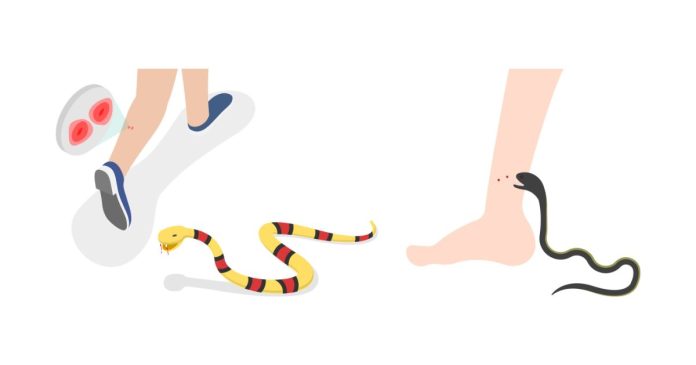Have you ever wondered what might happen if you were bitten by a water moccasin? This venomous snake, also known as a cottonmouth, is notorious for its aggressive behavior and dangerous bite. These snakes are often found in the southern United States, near water sources like rivers, lakes, and swamps, making it important to understand what to do if you’re ever in a situation where you’re bitten by one.
In this blog post, we’ll dive into what happens when you get bitten by a water moccasin, the symptoms to watch out for, and the crucial steps you should take if you ever find yourself in such a situation.
What Is a Water Moccasin?
A water moccasin (Agkistrodon piscivorus), often referred to as a cottonmouth, is a venomous snake that belongs to the pit viper family. It’s found primarily in the southeastern United States and prefers wetland environments. The name “cottonmouth” comes from the snake’s habit of opening its mouth wide to display its white, cotton-like interior when threatened.
These snakes are highly protective of their territory, and while they typically try to avoid humans, they can become aggressive if provoked or threatened.
What Happens When You Get Bitten?
If you’re bitten by a water moccasin, several things happen quickly. Here’s what to expect:
- Immediate Pain: The bite will likely cause immediate sharp pain, similar to being stung by a bee but more intense. This is due to the venom being injected into the wound. The bite area will typically swell and may become red or discolored.
- Swelling and Bruising: After the bite, you may experience rapid swelling around the area. Bruising can also occur as the venom begins to spread through your body. The venom can cause tissue damage, leading to necrosis (death of tissue) in severe cases.
- Symptoms of Poisoning: As the venom spreads, more systemic symptoms may appear. These can include:
- Nausea and vomiting
- Dizziness and weakness
- Blurred vision
- Difficulty breathing
- Heart palpitations
- Excessive sweating or chills
These symptoms can worsen over time and may lead to more severe issues like kidney failure or shock if not treated promptly.
How Dangerous Is a Water Moccasin Bite?
The danger posed by a water moccasin bite largely depends on the amount of venom injected, the location of the bite, and how quickly you receive medical attention.
Water moccasin venom contains a mixture of hemotoxins (which break down blood cells and tissue) and neurotoxins (which affect nerve function). This makes their bite potentially life-threatening, especially if the bite occurs near major blood vessels or vital organs. Without prompt treatment, there is a risk of severe tissue damage, infection, or even death.
What to Do If You’re Bitten by a Water Moccasin
If you or someone else is bitten by a water moccasin, it’s critical to act quickly. Here are the steps you should follow:
- Stay Calm: While it’s easier said than done, staying calm can help slow the spread of venom through your bloodstream. Try to keep the bite area elevated and as still as possible.
- Get Medical Help Immediately: Call 911 or emergency services as soon as possible. A water moccasin bite requires immediate medical attention, and the quicker you can get antivenom, the better the chances of recovery.
- Avoid Using Tourniquets: While some people may think to use a tourniquet to stop the venom from spreading, this is generally not recommended as it can cause further tissue damage.
- Do Not Attempt to Suck Out the Venom: This is a dangerous myth. Sucking out the venom or cutting the wound will not help and can actually introduce bacteria into the wound.
- Keep the Affected Limb Still: If possible, keep the bitten limb immobilized at or slightly below the level of the heart to slow the spread of the venom.
Treatment for a Water Moccasin Bite
Once you reach a medical facility, the treatment will depend on the severity of the bite. Common treatments include:
- Antivenom: In cases where the bite is severe, antivenom will be administered to neutralize the venom and prevent it from causing further harm.
- Pain Management: Doctors may administer pain relief to manage the discomfort caused by the bite.
- Wound Care: The bite area will be cleaned and monitored for signs of infection or tissue damage. If necessary, surgery may be required to remove dead tissue.
Can You Survive a Water Moccasin Bite?
Yes, with prompt medical treatment, most people who are bitten by a water moccasin survive. However, the severity of the bite can vary, and some individuals may experience long-term effects, such as scarring, nerve damage, or loss of function in the affected limb. The key to survival is quick action and proper medical care.
Prevention: How to Avoid Getting Bitten
While water moccasins are dangerous, they don’t typically seek out humans. To avoid being bitten:
- Be aware of your surroundings: If you’re hiking or spending time near water in regions where water moccasins live, be cautious and watch for snakes.
- Wear protective gear: Sturdy boots and snake-proof clothing can offer some protection in areas known for venomous snakes.
- Give snakes space: If you encounter a water moccasin, back away slowly and avoid disturbing it. These snakes typically prefer to stay away from humans if given the chance.
Handling a Water Moccasin Bite
Getting bitten by a water moccasin can be a frightening experience, but with the right knowledge and quick medical attention, the chances of a full recovery are high. Remember, the best way to stay safe is to avoid encounters with these venomous snakes whenever possible. If you are bitten, stay calm, get help immediately, and follow the necessary steps to treat the bite effectively.
Understanding how to react in the event of a water moccasin bite can help you stay safe and prepared in snake-prone areas.


